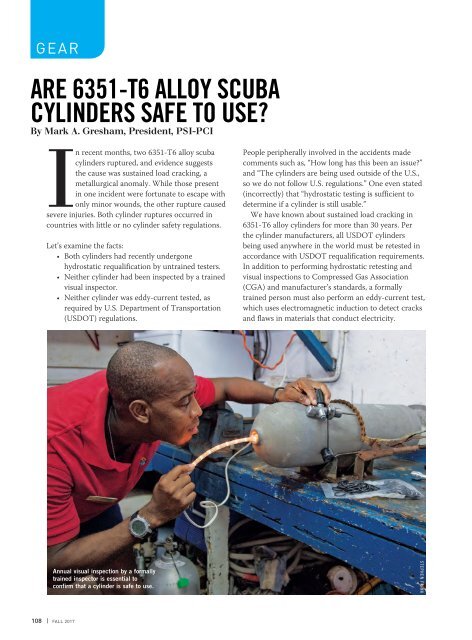AD 2017 Q4
Alert Diver is the dive industry’s leading publication. Featuring DAN’s core content of dive safety, research, education and medical information, each issue is a must-read reference, archived and shared by passionate scuba enthusiasts. In addition, Alert Diver showcases fascinating dive destinations and marine environmental topics through images from the world’s greatest underwater photographers and stories from the most experienced and eloquent dive journalists in the business.
Alert Diver is the dive industry’s leading publication. Featuring DAN’s core content of dive safety, research, education and medical information, each issue is a must-read reference, archived and shared by passionate scuba enthusiasts. In addition, Alert Diver showcases fascinating dive destinations and marine environmental topics through images from the world’s greatest underwater photographers and stories from the most experienced and eloquent dive journalists in the business.
You also want an ePaper? Increase the reach of your titles
YUMPU automatically turns print PDFs into web optimized ePapers that Google loves.
GEAR<br />
ARE 6351-T6 ALLOY SCUBA<br />
CYLINDERS SAFE TO USE?<br />
By Mark A. Gresham, President, PSI-PCI<br />
In recent months, two 6351-T6 alloy scuba<br />
cylinders ruptured, and evidence suggests<br />
the cause was sustained load cracking, a<br />
metallurgical anomaly. While those present<br />
in one incident were fortunate to escape with<br />
only minor wounds, the other rupture caused<br />
severe injuries. Both cylinder ruptures occurred in<br />
countries with little or no cylinder safety regulations.<br />
Let’s examine the facts:<br />
• Both cylinders had recently undergone<br />
hydrostatic requalification by untrained testers.<br />
• Neither cylinder had been inspected by a trained<br />
visual inspector.<br />
• Neither cylinder was eddy-current tested, as<br />
required by U.S. Department of Transportation<br />
(USDOT) regulations.<br />
People peripherally involved in the accidents made<br />
comments such as, “How long has this been an issue?”<br />
and “The cylinders are being used outside of the U.S.,<br />
so we do not follow U.S. regulations.” One even stated<br />
(incorrectly) that “hydrostatic testing is sufficient to<br />
determine if a cylinder is still usable.”<br />
We have known about sustained load cracking in<br />
6351-T6 alloy cylinders for more than 30 years. Per<br />
the cylinder manufacturers, all USDOT cylinders<br />
being used anywhere in the world must be retested in<br />
accordance with USDOT requalification requirements.<br />
In addition to performing hydrostatic retesting and<br />
visual inspections to Compressed Gas Association<br />
(CGA) and manufacturer’s standards, a formally<br />
trained person must also perform an eddy-current test,<br />
which uses electromagnetic induction to detect cracks<br />
and flaws in materials that conduct electricity.<br />
Annual visual inspection by a formally<br />
trained inspector is essential to<br />
confirm that a cylinder is safe to use.<br />
STEPHEN FRINK<br />
108 | FALL <strong>2017</strong>









